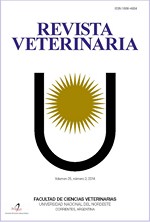Capacidad de Lactiplantibacillus plantarum de reducir biofilms de bacterias patógenas transmitidas por alimentos
DOI:
https://doi.org/10.30972/vet.3315879Palavras-chave:
Lactiplantibacillus plantarum, biofilms, patógenos, enfermedades transmitidas por alimentosResumo
El uso de L. plantarum LP5 con potencial probiótico puede ser un enfoque alternativo para reducir la formación de biofilms de patógenos involucrados en enfermedades transmitidas por alimentos (ETA) en las industrias alimentarias. El objetivo de este estudio fue evaluar la capacidad reductora de biofilms de L. plantarum sobre el biofilms de Escherichia coli productor de toxina Shiga, Salmonella tiphymurium y Staphylococcus aureus. Fueron realizados tres ensayos: competencia, exclusión y desplazamiento. En las pruebas de competencia y exclusión, la producción de biofilms de STEC, S. tiphymurium y S. aureus fueron reducidas por efecto antibacteriano de L. plantarum LP5 (p<0,01). En la prueba de desplazamiento, si bien el biofilm producido por S. aureus, ejerció resistencia frente a L. plantarum LP5 (p<0,01), los biofilms de STEC y S. tiphymurium fueron reducidos al incorporar el cultivo de L. plantarum LP5 (p<0,01). Por lo tanto, el efecto antagónico de L. plantarum LP5 demostrado por la capacidad reductora de biofilms de bacterias patógenas involucradas en ETA lo convierte en una cepa con potencial aplicación antibacteriana en la industria alimentaria.
Downloads
Referências
Castellano P et al. 2017. Strategies for pathogen biocontrol using lactic acid bacteria and their metabolites: a focuson meat ecosystems and industrial environments. Microorganisms 5: 38.
Colello R et al. 2018. Detection and characterization of Salmonella serotypes in the production chain of two pig farms in Buenos Aires Province, Argentina. Front Microbiol 9: 1370.
Collado MC, Meriluoto J, Salm inen S. 2007. Role of commercial probiotic strains against human pathogen adhesion to intestinal mucus. JA ppl Microb 45: 454-460.
Chmielewski RA, Fran k JF. 2003. Biofilm formation and control in food processing facilities. Compr Rev Food Sci Food S a f2: 22-32.
Chole RA, Faddis BT. 2003. Anatomical evidence of microbial biofilms in tonsillar tissues: a possible mechanism to explain chronicity. Arch Otolaryngol Head Neck Surg 129: 634-636.
Flemming HC, Wuertz S. 2019. Bacteria and archaea on Earth and their abundance in biofilms. Nat Rev Microbiol 17: 247-260.
Gómez NC, Ramiro JM , Quecan BX, Melo BD. 2016. Use of potential probiotic lactic acid bacteria biofilms for the control of histeria monocytogenes, Salmonella typhimurium and Escherichia coli: H7 biofilms formation. Front Microbiol 7: 863.
Jalilsood T et al. 2015. Inhibition of pathogenic and spoilage bacteria by a novel biofilm-forming Lactobacillus isolate: a potential host for the expression of heterologous proteins. Microb CellFact 14: 1-14.
Jones SE, Versalovic J. 2009. Probiotic Lactobacillus reuteri biofilms produce anti-microbial and anti-inflammatory factors. BMC Microbiol 9: 1-9.
Khelissa SO, Abdallah M, Jam a C, Faille C, Chihib NE. 2017. Bacterial contamination and biofilm formation on abiotic surfaces and strategies to overcome their persistence. JM ater Environ Sci 8: 3326-3346.
Ndahetuye JB , Koo OK, O’B ryan CA, Ricke RC, Crandall PG. 2012. Role of lactic acid bacteria as a bio-sanitizer to prevent attachment of histeria monocytogenes F6900. N at Rev Microbiol 17: 247-260.
Ouali FA et al. 2014. Identification of lactobacilli with inhibitory effect on biofilm formation by pathogenic bacteria on stainless steel surfaces. Int J FoodM icrobiol 191: 116-124.
Ruiz MJ, Colello R, Padola NL, Etcheverría AI. 2017. Efecto inhibitorio de Lactobacillus sp sobre bacterias implicadas en enfermedades transmitidas por alimentos. Rev Argent Microbiol 49: 174-177.
Ruiz M J et al. 2021. In vitro screening and in vivo colonization pilot model of Lactobacillus plantarum LP5 and Campylobacter coli DSPV 458 in mice. Arch Microbiol 1-11.
Singh S, Singh SK, Chowdhury I, Singh R. 2017. Understanding the mechanism of bacterial biofilms resistance to antimicrobial agents. Open Microbiol J 11: 53.
Suresh MK, Biswas R, Biswas L. 2019. An update on recent developments in the prevention and treatment of Staphylococcus aureus biofilms. Int JM edM icrobiol 309: 1-12.
T atsaporn T, K ornkanok K. 2020. Using potential lactic acid bacteria biofilms and their compounds to control biofilms of foodborne pathogens. Biotechnol Rep (Amst) 26: e00477.
Woo J, A hn J. 2013. Probiotic mediated competition, exclusion and displacement in biofilm formation by foodborne pathogens. Lett Appl Microbiol 56: 307-313.
Zinigul S, G ulm ira B, ZaKarya K, R aikhan D, A khan A. 2016. Screening of lactic acid bacteria for antagonism toward pathogens and biofilm-forming activity. Earth Science Reviews 11: 12.
Downloads
Publicado
Como Citar
Edição
Seção
Licença
Política de acceso abierto
Esta revista proporciona un acceso abierto inmediato a su contenido, basado en el principio de que ofrecer al público un acceso libre a las investigaciones ayuda a un mayor intercambio global de conocimiento. La publicación por parte de terceros será autorizada por Revista Veterinaria toda vez que se la reconozca debidamente y en forma explícita como lugar de publicación del original.
Esta obra está bajo una licencia de Creative Commons Reconocimiento-NoComercial 4.0 Internacional (CC BY-NC 4.0)










.jpg)
.jpg)



